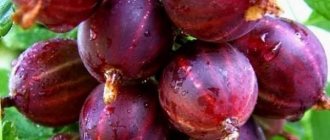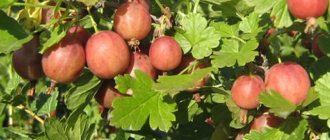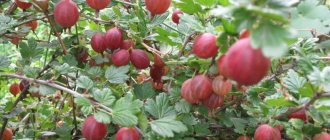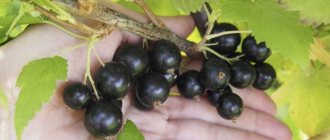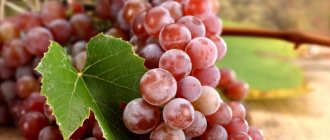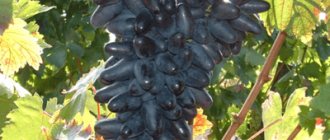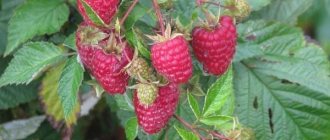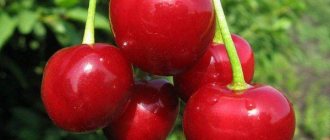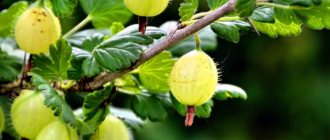- 3.1 Growing rules
Growing gooseberries in the European and Central parts of the Russian Federation became possible after the emergence of cultivars resistant to frost and disease. Gooseberry Rodnik is a selection variety created in 2001 by I. Popov and M. Simonov based on the mid-early species Lada and Purmen. After experimental cultivation, the variety fully confirmed the characteristics given by the originators, and in 2004 it was entered into the State Register.
What kind of gooseberry is this?
The variety was obtained by crossing the mid-early gooseberry Lada and a seedling from free self-pollination Purmen. Moscow breeders I.V. Popova and M.N. Simonova managed to combine many positive properties in one plant.
In 2001, the variety was included in the State Register as recommended for cultivation in the Central region of Russia. It is cultivated in the middle zone, the European part, and in the southern regions. The Rodnik gooseberry demonstrates its maximum fruiting abilities in the Moscow, Tula, Ryazan, Vladimir, Bryansk, and Smolensk regions.
Gooseberry Spring: characteristics and description of bushes
The plant forms compact and dense bushes 1.2 m high with drooping tops and straight thick branches that change color from green to dark gray as they grow. Few, sparse thorns (1-2 per 40-50 cm) of medium thickness, up to 11 mm long, are concentrated mainly in the lower parts of the stems, at a distance of 20 cm from the root.
The buds are brown, large, oval in shape and deviated from the shoot. The compressed crown is formed by large green five-lobed leaves with wavy edges, a slight shine and a leathery surface, pubescent below. Flowers of different sexes are large, cone-shaped, collected in 2-3 pieces. at each leaf node. The sepals are light green with red-lilac streaks.
Reference. Gooseberry Spring bears fruit in the second year after transplanting to a permanent place.
Temperature resistance
Rodnik borrowed high frost resistance from its parent varieties. The plant is resistant to sudden temperature changes and survives severe frosts down to -35°C. Spring frosts do not damage the flowers. If the shoots freeze during the growing season, the bush fully increases its green mass and root system.
Moisture and drought resistance
The drought resistance of gooseberries is average, which is typical for almost all plants with a superficial root system. Lack of moisture affects the fruits: they lose weight, density and become sour.
Resistance to diseases and pests
The variety is characterized by a high level of resistance to infections and gets sick extremely rarely. The only pest that parasitizes the bush is aphids.
Main characteristics
Gooseberries are early ripening, grow with spreading branches and tasty berries. There are also some features of this variety.
Watch a review of the “Spring” variety in the video below:
Bush
The shrub is low, with wide, long branches. There are thick shoots that become woody as they mature. The shoots have thorns, but not dense ones - there are only 2-3 thorns per 0.5 m of branch and only at the bottom of the bush. The foliage is wide and bright green. The leaf is slightly hairy underneath and smooth on top.
Berries
The fruits are large, weighing 5 g per piece, round in shape. When ripe, they acquire a green-yellow color with a slight red tint. The skin is not too thick, but reliable, fleshy with a hint of gooseberry aroma. The taste is sweet with a slight sourness.
Maturation period
Gooseberry Rodnik is one of the best representatives of the early ripening variety. The fruits can be obtained in the first days of summer. The culture is highly frost-resistant, so it can easily withstand harsh winters, strong winds and frosts in the spring season.
Productivity
The first berries can be obtained in the 2nd year after planting, but everything depends on the growing conditions and care for the bush. With proper care of the plant, you can get about 11 kg of juicy sweet berries from 1 bush.
Usage
Gooseberries are famous for their unsurpassed taste and can be consumed fresh. Excellent for preparing refreshing drinks and summer salads. For the winter, jams, jams and compotes are made from gooseberries. Some housewives even bake pies with Spring berries.
Transportability
The skin is not too dense, but it can withstand transportation, while the fruits do not lose their taste and presentation. However, for transportation, fruits should be collected during the period of technical maturity.
Characteristics and description of fruits
Large oval berries are yellow-green in color with veins as they ripen and acquire a reddish tint on the sides. The outer skin is thin but durable, with a slight waxy coating. The weight of the fruit is uneven, ranging from 4 to 7 g.
The aromatic and juicy green pulp with a small number of small seeds has a harmonious sweet and sour taste and contains 7.3% sugars and 2% acid. Tasting score: 4.9 points.
Reference. The average yield, according to long-term observations, is 7.5 kg per bush.
Areas of use
Ripe berries are used both fresh and frozen. They are used to make jam, preserves, compote, marinade, and wine.
Harvest and storage
The berries of the Rodnik variety begin to ripen from the end of June. Ripening occurs simultaneously, therefore, the harvest can be harvested at one time.
If you are going to make jam from the berries, then they should be collected a little before full ripeness, and for fresh consumption, take those berries that are fully ripe.
Slightly unripe gooseberry fruits are stored for no longer than 10 days in a cool, dry place. If there is a need for long-term storage, then the berries should be completely dried and placed in open boxes, where they will be stored at zero temperature for 1.5 months. This storage is suitable only for undamaged berries. To preserve the harvest longer, it is frozen in freezers.
Fully ripe fruits can be stored in the refrigerator for no longer than 4 days.
Advantages and disadvantages of the variety
Gooseberry benefits:
- good rooting ability;
- high, stable yield;
- early ripening;
- a small number of thorns;
- resistance to frost and temperature fluctuations;
- excellent taste of berries;
- self-fertility;
- stable immunity to major diseases;
- versatility of fruits;
- good transportability;
- long shelf life.
Disadvantages of the variety:
- ripe berries fall off after rain;
- average resistance to aphids.
Growing technology
Gooseberries are not picky about soil and thrive in all types except acidic and waterlogged ones. When groundwater is closer than 1-1.5 m, the plant is depressed and may die, and during prolonged drought it does not form flower buds and sheds its leaves. The crop is planted in soil heated to +6°C.
The bushes do not like thickening and shading; with a lack of lighting, development is inhibited, and resistance to diseases and pests is reduced. The quality of the berries deteriorates and ripening occurs unevenly.
It is advisable to plant gooseberries in flat, well-lit, sunny, draft-protected areas, avoiding low spots and shade. The best predecessors are vegetables and strawberries. It is not advisable to plant after raspberries and currants.
Landing dates and rules
It is better to plant in autumn or early spring before the buds bloom on the branches. Seedlings with a closed root system are planted even in summer:
- the size of the hole depends on the size of the root system; for a young plant, the optimal parameters are 40x40x40 cm;
- roots longer than 20 cm are removed;
- for planting, prepare a composition of organic matter, peat, wood ash and sand;
- drainage and ½ part of the nutrient mixture are placed at the bottom of the hole;
- the seedling is placed vertically or at an angle in the center;
- pour out the rest of the substrate and compact it;
- water, mulch;
- shoots are pruned to the level of 4 fruit buds.
Further care
Further care consists of moderate watering, the frequency of which depends on weather factors. The indicator for its implementation is dry soil in tree trunk circles. If there is excess rain, a drainage ditch is dug at a distance of 30 cm from the trunk to drain excess water. The crust on the soil surface is destroyed by shallow loosening. At the same time, weeds are removed.
The bush is formed with 10-13 stems. Health pruning is carried out in early spring, removing damaged and dry shoots. Trunks older than 8 years are pruned at the root. After collecting the berries, the gooseberries are thinned out and twisted branches are removed.
From the second year of life, the plant is fed: in the spring - with nitrogen fertilizers, during the period of fruit ripening - with organic fertilizers.
Possible problems, diseases and pests
In cold, rainy summer conditions, a fungal infection may appear, which manifests itself as a bluish coating on the berries. To prevent infection, gooseberries must be treated with fungicides in the spring.
The plant may be attacked by aphids. To avoid this, timely spraying with any insecticide is required.
Wintering
For the winter, the bush is collected in a bundle and tied so that the shoots do not break from the snow. Carry out the last watering, hill up and cover with a layer of mulch.
Diseases and pests
Gooseberry Spring has high immunity to many diseases. In fact, the variety rarely gets sick.
In cold and rainy summers, a white coating may appear on the berries. Drugs such as Topaz and Oxychom will help in the fight against fungus. As a preventive measure, in early spring, gooseberry bushes are sprayed with a solution of copper sulfate and potassium hydroxide.
Aphids, which suck the juice from the plant, are fought with a soap solution. From ants using baits and other chemicals.
The author of the video will tell you more about the advantages of the gooseberry variety Rodnik.
Reproduction
The main methods of propagation are cuttings, the use of layering, and dividing the bush.
In June, cuttings 12-15 cm long are cut and planted to a depth of 1.5 cm in fertile, moist soil under a film cover, watering periodically.
Gooseberry Spring can be propagated by layering. A strong young shoot is bent down and covered with earth. In spring, rooted stems are cut off and planted.
Reference. The most productive way is to divide the bush.
Reproduction must be carried out in the spring, around mid-May. Separate bushes that are at least 4 years old. The plant responds well to transplantation and quickly takes root.
Features of growing gooseberries Rodnik depending on the region
In the middle zone and to the north, you need to choose the sunniest places for planting; to the south it is better to find openwork shade for the bush so that sunburn does not damage the foliage and crop.
Autumn planting in cold zones is carried out a month before the arrival of frost, in temperate climates - in early September, in warm regions the period is extended until mid-October. In areas with a variable climate, it is advisable to plant in spring. The optimal time for central Russia is mid-May, for the southern regions - April.
Planting and care
Planting of the Spring can be done in spring and autumn, depending on climatic conditions. It is advisable to choose a place for gooseberries that is sunny, dry, with loose and nutritious soils that have neutral acidity. The groundwater level should be no higher than 1.5 meters to the surface. The distance to neighboring plants is at least 1 meter. Moderate watering is required, fertilizing is carried out according to the usual scheme. To maintain the large-fruited variety, annual pruning is needed. After thinning, well-lit branches bloom profusely and bear a good harvest. In addition, the risk of fungal diseases and insect infestations is reduced. The culture reproduces well by layering and cuttings.
The spring is especially suitable for the climatic conditions of central Russia. The plant is unpretentious and easy to grow using standard care rules. The variety is valued for its good yield, large fruit, high frost resistance and good immunity. Thanks to the excellent self-fertility of gooseberries, you can save space in a small garden, since there is no particular need for planting a pollinator. The number of thorns on the plant is small, so during harvesting the hands practically do not suffer. The only negative is the fruits fall off in rainy weather.
Reviews from summer residents
Summer residents who grow Rodnik on their plots note the variety’s high yield and resistance to disease.
Elena, 52 years old : “An excellent variety for those who want to collect large, moderately sweet gooseberries. There is some sourness in the taste, but it is insignificant compared to many other types. I’m happy with the gooseberries, I’ll try to propagate them.”
Vladimir, 46 years old : “The Rodnika bush has been growing on my site for 5 years and meets the varietal characteristics. Over the years there have been no problems with diseases or pests. The yield is encouraging every year.”
